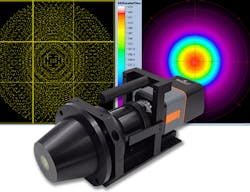Radiant Launches Near-infrared Intensity Measurement Solution to Test Accuracy and Safety of 3D Sensing Devices
Radiant Vision Systems, a leading provider of test and measurement solutions for lighting and displays, announces the release of a new Near-Infrared (NIR) Intensity Lens for measuring NIR-emitting LED and laser sources used in non-visible 3D sensing applications such as facial recognition and eye tracking. Radiant’s NIR Intensity Lens system is mounted directly to a Radiant ProMetric® Y16 (16-megapixel) Imaging Radiometer and uses Fourier optics to enable single-image analysis of the full angular distribution of a NIR light source. With hundreds of units already in use at test sites around the globe, the Radiant NIR Intensity Lens greatly reduces the time and complexity of comprehensive NIR source characterization, enabling production-level analysis.
“To correctly assess the function of NIR devices, a measurement system has to determine the radiant intensity of NIR emissions across its complete distribution area,” says Doug Kreysar, Chief Solutions Officer at Radiant Vision Systems. “Traditional light measurement methods like goniometric systems capture comprehensive angular emission data, but may take hours for a complete analysis and lack the resolution required,” he explained. “Common for facial recognition, diffractive optical element (DOE) dot patterns disperse a laser beam into hundreds or even thousands of individual dots that must be measured, and only an imaging system has the speed and resolution to make this measurement practical.”
Using Radiant’s NIR Intensity Lens, angular measurements of NIR light distributions can be obtained instantly and comprehensively, greatly reducing test time while improving accuracy over goniometric systems. Using Fourier “conoscopic” optics, the Radiant lens system maps each emission angle from a NIR light source onto the imaging system’s CCD to capture a two-dimensional polar plot of the angular distribution, which is used to evaluate the complete scope of NIR emissions for inconsistencies in radiant intensity, power, and radiant flux across three-dimensional space.
The use of near-IR emissions for 3D sensing is growing rapidly in various industrial and medical applications, as well as consumer devices such as smart phones, augmented and virtual reality devices, smart home systems, and even automobile LiDAR. The 3D imaging and sensing market is projected to reach $18.5 billion by 2023 according to the report 3D Imaging & Sensing 2018 by Yole Development (June 2018). With this growth, the need for effective, production-ready measurement systems is critical for mass manufacturing of safe and quality NIR-sensing devices.
Radiant’s NIR Intensity Lens solution is the first commercially available Fourier optic for NIR measurement. The system captures accurate radiometric values to +/- 70 degrees with approximately 0.05-degree pixel resolution at every point measured. The system is designed for precise measurement of wavelengths from 930-950 nanometers—the range used by many devices for user-safe 3D sensing applications such as facial recognition.
The NIR Intensity Lens system can evaluate emission uniformity, total flux (mW or W), radiant intensity (min/max), as well as analyze flood distributions of diffuse NIR light sources to evaluate uniformity across angular emissions (intensity at each degree), center values, angular fall-off, hotspots, and time of flight (TOF) performance. For applications that use DOE such as facial recognition, the system automatically identifies points of interest for each dot in DOE patterns, dynamically adapting to new patterns regardless of dot position, shape, or size.
Radiant’s NIR Intensity Lens solution captures DOE pattern data in detail and outputs CSV reports containing data specific to complete DOE patterns, regions of interest, and for each dot. This statistical DOE data includes maximum peak (strongest emitter) location at x,y, maximum peak inclination/azimuth, maximum peak average, maximum peak solid angle, number of pixels at maximum peak point, spot power uniformity (between dots), total flux, and DOE flux (subtracting the background peak).
For information about the NIR Intensity Lens and other light and color test and measurement solutions, visit www.RadiantVisionSystems.com.
About Radiant Vision Systems
Radiant Vision Systems works with world-class brands and manufacturers to deliver creative visual inspection solutions that improve quality, reduce costs, and increase customer satisfaction. Radiant’s legacy of technology innovation in photometric imaging and worldwide install base date back more than 25 years and address applications from consumer electronics to automotive manufacturing. Radiant Vision Systems product lines include TrueTest™ automated visual inspection software for quality control, and ProMetric® imaging colorimeters, photometers, and light source measurement systems. Radiant is headquartered in Redmond, Washington, USA, with strategic offices in California, China, and South Korea. Radiant has been a part of Konica Minolta’s Sensing Business Unit since August 2015. For more information, visit www.RadiantVisionSystems.com.
